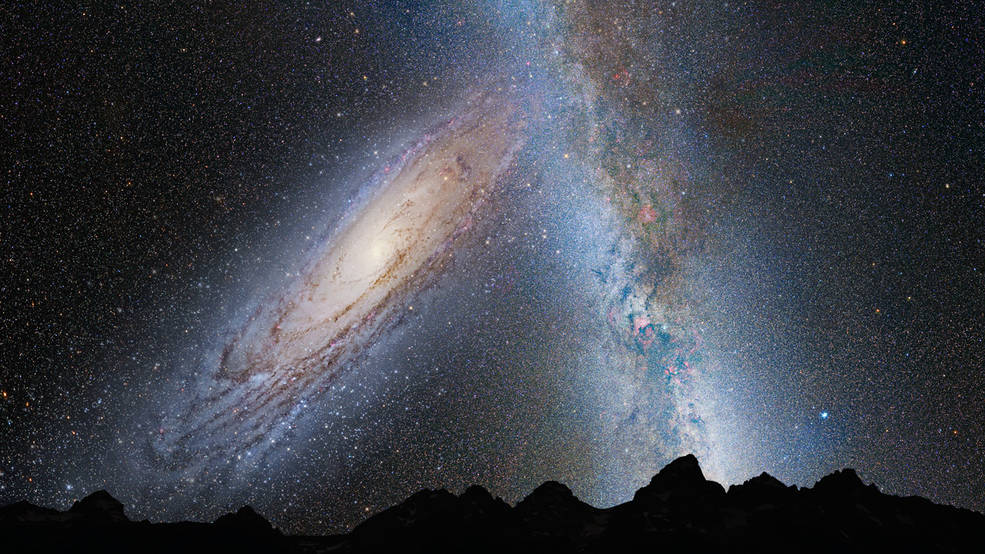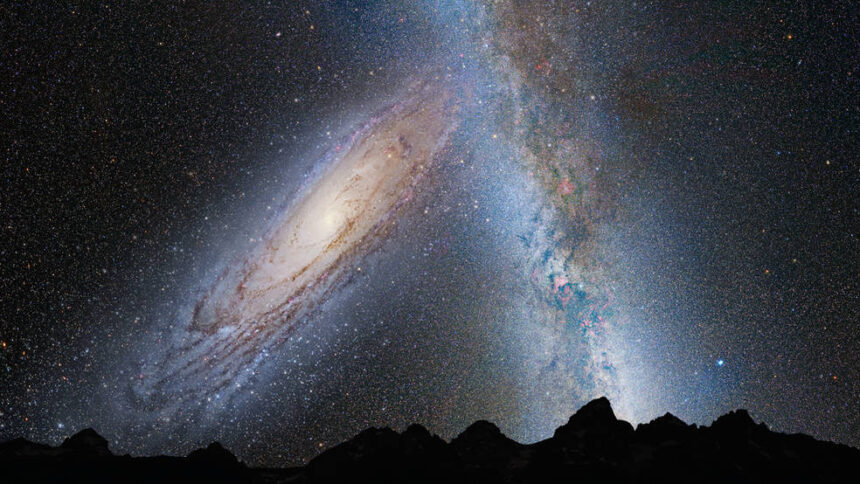Although it may seem like something out of a science fiction movie, the Andromeda and Milky Way Galaxy are actually on a collision course. Scientists have known about this impending collision for years, and have been carefully monitoring the two galaxies to see how they will interact. While the final outcome is still uncertain, researchers are expecting some pretty dramatic changes when the two galaxies finally meet.
So what do we know about this impending galactic smash-up? Keep reading to find out When will the Andromeda and Milky Way Galaxy Collide.
⫸ What is the Andromeda Galaxy and what is the Milky Way Galaxy?
The Andromeda Galaxy and the Milky Way Galaxy are two of the most iconic galaxies in the night sky. And Andromeda is the closest major galaxy to our own, and it’s visible to the naked eye on a clear night. The Milky Way, on the other hand, is our home galaxy – a spiral of stars, gas, and dust that contains our Solar System. Both galaxies are incredibly massive, and they’re each thought to contain around a trillion stars.
The Andromeda is slightly larger than the Milky Way, but both are so big that they’re difficult to imagine.
⫸ Andromeda Galaxy vs Milky Way Galaxy:
Two of the most well-known galaxies are the Andromeda Galaxy and the Milky Way Galaxy. Andromeda is our nearest major galactic neighbour, located 2.5 million light-years away. The Andromeda Galaxy is a spiral galaxy, much like the Milky Way, and is about 780 thousand light-years across. In contrast, the Milky Way is about 100 thousand light-years across.
The Andromeda contains about one trillion stars, while the Milky Way only has between 200 and 400 billion stars. Even though Andromeda is much larger than the Milky Way, both galaxies are thought to have about the same mass. One interesting fact about Andromeda is that it is on a collision course with the Milky Way Galaxy. It is predicted that in about 4 billion years, the two galaxies will collide.
⫸ When will the Andromeda and Milky Way Galaxy Collide?
The Milky Way and Andromeda galaxies are both spiral galaxies. They will collide in about 4 billion years. The Milky Way is larger than Andromeda, so it will eventually consume Andromeda. The stars in the two galaxies will not actually collide, but they will pass through each other’s gravitational fields. This interaction will cause some stars to be ejected from their galaxies and others to be pulled into new orbits. The merger of the two galaxies will also create new stars and planets.
Some scientists believe that the collision of the Milky Way and Andromeda galaxies could cause our galaxy to change its shape. The merger could cause the Milky Way’s spiral arms to merge and form a new, thicker disk. The merger could also cause our galaxy to spin faster.
The merger of the Milky Way and Andromeda galaxies will be a spectacular event to watch. It’s something that we can only witness once because after it happens, the two galaxies will be merged forever.
⫸ What will happen when they collide?
When the two galaxies collide, there will be a lot of destruction. The stars in the Milky Way and Andromeda galaxies will merge, creating new stars. However, many of the stars in both galaxies are old and won’t survive the collision. The gas and dust between the stars will also be compressed, causing it to heat up and glow.
Despite all of the destruction, astronomers believe that the collision will be a beautiful sight. The new stars created by the collision will shine brightly and the gas and dust will create a spectacular Milky Way-Andromeda galaxy hybrid.
4 billion years may seem like a long time, but it’s actually pretty short when you compare it to the age of the universe. The Milky Way and Andromeda galaxies have been orbiting each other for about 9 billion years and they will keep orbiting each other for another 5 billion years after the collision. So, in a sense, we will get to see the collision twice!
Read: ✅ What is White Whole?
⫸ What scientists are doing to try and prevent the collision?
It’s been long-standing scientific speculation that the Milky Way and Andromeda galaxies will eventually collide. But when will this actually happen? And what damage the collision will cause and develop plans to minimize the damage?
The collision is expected to happen around 4.5 billion years from now. The two galaxies will merge to form a single, larger galaxy. The new galaxy will be called Milky Way Plus or Andromeda Galaxy.
The collision will cause a lot of damage. The stars in the Milky Way and Andromeda galaxies will collide and merge, creating huge explosions. These explosions will send shock waves through the galaxies, causing even more damage.

The gas and dust between the stars will also collide. This will create huge clouds of gas and dust that will block the light from the stars. This will make the galaxies very dark and difficult to study.
The collision will also cause new stars to form. Some of these stars will be very large and powerful. They will have a short life span and will explode as supernovas.
Scientists are still trying to figure out what will happen when the Milky Way and Andromeda galaxies collide. However, they do know that it will cause a lot of damage. By studying how the two galaxies interact, they can develop plans to minimize the damage. The collision is expected to happen around 4.5 billion years from now, so there is still time to prepare.
⫸ The possible consequences of a collision between the two galaxies:
There are many possible consequences of a collision between the Milky Way and Andromeda galaxies. Some of these consequences include the following:
- The collision could cause huge amounts of gas and dust to be thrown out into space. This could block the light from distant stars, and it could also prevent new stars from being formed.
- The collision could cause the Milky Way and Andromeda galaxies to merge. This would create a brand new galaxy that would be much larger than either of the original galaxies.
- The collision could cause the Milky Way and Andromeda galaxies to split apart. This would create two smaller galaxies, which would orbit around each other.
- The collision could cause the Milky Way and Andromeda galaxies to remain in their current state. This would mean that they would continue to move closer and closer to each other until they eventually collide.
⫸ Conclusion:
So, when will the Andromeda and Milky Way Galaxy collide? Scientists have a few theories about how the two galaxies might collide. It’s possible that they will merge, or that Andromeda will pass through the Milky Way. However, it’s more likely that they will hit each other head-on. The consequences of this collision are still being studied, but scientists believe it could cause massive damage to both galaxies. In light of this information, what do you think we should do? Share your thoughts in the comments below!
◉ FAQs of When will the Andromeda and Milky Way Galaxy Collide:
Q. What is the Andromeda Galaxy?
A: The Andromeda Galaxy is a spiral galaxy that is located 2.5 million light-years from Earth.
Q. How big is the Andromeda Galaxy?
A: The Andromeda galaxy is about 220,000 light-years in diameter.
Q. What is the temperature of the Andromeda Galaxy?
A: The temperature of the Andromeda Galaxy is about -100 degrees Celsius.
Q. How many stars are in the Andromeda Galaxy?
A: There are about 1 trillion stars in the Andromeda galaxy.
Q. What is the Milky Way Galaxy?
A: The Milky Way Galaxy is a spiral galaxy that is located 100,000 light-years from Earth.
Q. How big is the Milky Way Galaxy?
A: The Milky Way galaxy is about 150,000 light-years in diameter.
Q. What is the temperature of the Milky Way Galaxy?
A: The temperature of the Milky Way Galaxy is about 0 degrees Celsius.
Q. What is the Milky Way Galaxy made of?
A: The Milky Way galaxy is made of gas and dust.
Q. How many stars are in the Milky Way Galaxy?
A: There are about 400 billion stars in the Milky Way galaxy.
Q. Will humans survive the Andromeda collision?
A: There is a 1 in 400,000 chance that humans will survive the Andromeda collision.
Q. What will happen when Andromeda hits us?
A: When Andromeda hits us, it will cause a big explosion.
Q. Is the Andromeda Galaxy bigger than the Milky Way Galaxy?
A: No, the Andromeda Galaxy is smaller than the Milky Way Galaxy.
Q. When will the Andromeda and Milky Way Galaxy Collide?
A: The Andromeda and Milky Way Galaxy will collide in about 4.5 billion years.
Q. What will happen when the Andromeda and Milky Way Galaxy collide?
A: The Andromeda and Milky Way galaxies will merge to form one large galaxy.
Q. What is the chance of a collision between the Andromeda and Milky Way Galaxy?
A: There is a 1 in 400,000 chance of a collision between the Andromeda and Milky way Galaxy.


I’m scared
None of us reading this will be alive in 4.5 BILLION years !